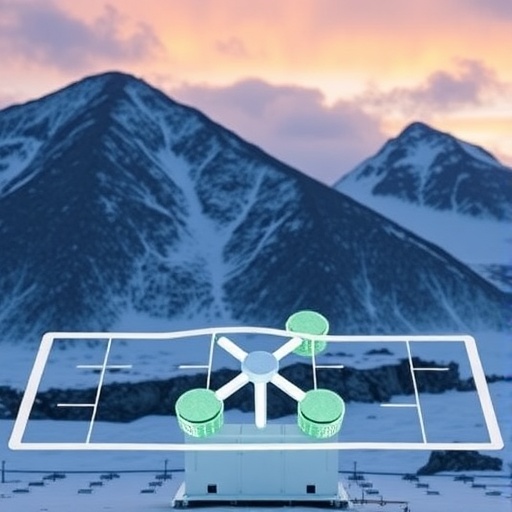In a groundbreaking development that reshapes our understanding of Earth’s climatic history, researchers have unveiled a vital link between metal-driven anaerobic oxidation of methane (AOM) and the Sturtian deglaciation, a pivotal event more than 700 million years ago. This revelation not only illuminates a crucial biogeochemical process but also offers fresh insight into the mechanisms that helped end one of Earth’s most extensive Snowball Earth glaciations.
The Sturtian glaciation, which occurred approximately 717 to 660 million years ago, represents a key interval in Earth’s Proterozoic eon, during which the planet experienced near-global ice coverage. For years, scientists have sought to unravel what processes triggered the eventual thawing of this frozen expanse. The work by Hu, Li, Wang, and their colleagues puts anaerobic oxidation of methane—specifically mediated by metal ions—in the spotlight as a decisive factor.
Methane, a potent greenhouse gas, can be produced through biological processes in anoxic environments. Traditionally, its anaerobic oxidation linked to sulfate reduction has been well documented, but in oceanic or sedimentary contexts depleted of sulfate, alternative pathways must prevail. This new study elegantly demonstrates that metal cofactors such as iron and manganese can drive AOM, providing a missing explanation for methane consumption during Earth’s deep past, especially under conditions characterized by limited sulfate availability.
Employing sophisticated geochemical analyses and isotopic tracing, the research team pieced together evidence from Proterozoic sediment records, revealing signatures indicative of metal-coupled methane oxidation. These signals correlate temporally with the decline in global ice coverage, implying that biological consumption of methane via metal-driven AOM contributed to the rise in atmospheric CO2 and greenhouse warming necessary for deglaciation.
What distinguishes this research is its interdisciplinary approach, integrating geochemistry, microbiology, and paleoclimatology. By simulating ancient environmental conditions in the laboratory and comparing these with natural sediment samples, the authors rigorously validate the hypothesis that iron and manganese oxides facilitated the anaerobic oxidation of methane. This mechanism would have served as a sink for methane, regulating its release into the atmosphere and modulating the climate.
The implications of this finding extend well beyond reconstructing a distant glacial event. Methane has long been recognized as one of the most influential yet elusive components in Earth’s climate puzzle. Understanding how ancient microbial communities harnessed metals for methane oxidation reveals a previously underestimated control on greenhouse gas fluxes, with parallels to modern anoxic marine environments and potential applications in climate models predicting future methane dynamics.
Furthermore, this study challenges existing paradigms that heavily focused on sulfate-driven methane oxidation. In the metal-rich, sulfate-poor oceans of the Neoproterozoic, alternative electron acceptors had to play significant roles. The research presented here fills this gap and suggests that biogeochemical cycling of metals was intricately intertwined with methane regulation, serving as an ancient thermostat and shaping Earth’s evolutionary trajectory.
Deglaciations like the Sturtian set the stage for significant biological innovation, including the rise of complex multicellularity. By deciphering the drivers behind these thawing episodes, Hu and colleagues contribute to a deeper understanding of how Earth’s biosphere and climate co-evolved, prompting reconsideration of feedback loops that enhanced habitability in a previously inhospitable frozen planet.
The metal-driven AOM mechanism also raises provocative questions about the extent to which microbial metabolisms have influenced Earth’s atmospheric composition and climate on geological timescales. It underlines the adaptive versatility of early life forms in exploiting available chemical energy sources, performing crucial ecosystem functions under extreme environmental constraints.
Technically, the research leverages novel isotopic markers and microanalytical techniques. For instance, iron isotope fractionation patterns, combined with methane-derived carbon isotope signals, provide compelling geochemical fingerprints of metal-mediated AOM. The detection of these signals within Sturtian sedimentary deposits substantiates the role of this metabolism during glaciation.
Additionally, the authors use thermodynamic modeling to demonstrate that metal oxides could energetically support AOM under the cold, anoxic conditions prevalent during the Snowball Earth events. These energetics underpin a feedback mechanism by which methane emissions were curtailed, preventing runaway greenhouse warming yet allowing sufficient warming to trigger deglaciation.
From an evolutionary standpoint, the work hints at an ancient origin of metal-based methane oxidation pathways, pointing to the potential existence of specialized microbial consortia that thrived in Precambrian oceans. This expands current knowledge about the metabolic diversity of early life and the complexity of primordial biogeochemical cycles.
By addressing previously unexplained isotopic anomalies and geochemical distributions in sedimentary rock formations, this study also contributes to refining the proxy records used to reconstruct Earth’s climatic and environmental conditions. It asserts that metals could have left lasting imprints in the geochemical archive, which modern analytical methods can now decode with unprecedented precision.
Finally, this research opens promising avenues for exploring the role of metals in methane cycling on other planetary bodies. For example, understanding metal-driven AOM on Earth could analogically inform the search for life and biomarkers in extraterrestrial environments, such as the icy moons of the outer solar system, where methane and oxides are also likely abundant.
Altogether, the discovery of metal-driven anaerobic methane oxidation as a key moderator in the terminal phases of the Sturtian glaciation offers a profound leap forward in Earth sciences. It showcases how minute microbial processes, operating on invisible chemical reactions, can substantially influence planetary climate stability and biosphere evolution. The integration of geochemical, microbiological, and climatic data underscores the interdisciplinary effort required to decode Earth’s ancient history and forecast its future.
As research continues to unfold, this pivotal mechanism promises to be a cornerstone in resolving long-standing questions surrounding early Earth climate dynamics, infection points of greenhouse gas flux control, and the co-evolution of life and the environment. The study by Hu, Li, Wang, and colleagues thus stands as a testament to the remarkable complexity of Earth’s past and its relevance to contemporary planetary science.
Subject of Research: Metal-driven anaerobic oxidation of methane in relation to the Sturtian deglaciation.
Article Title: Metal-driven anaerobic oxidation of methane and the Sturtian deglaciation.
Article References:
Hu, J., Li, S., Wang, SJ. et al. Metal-driven anaerobic oxidation of methane and the Sturtian deglaciation.
Nat Commun 16, 7249 (2025). https://doi.org/10.1038/s41467-025-62622-z
Image Credits: AI Generated




